Yugoslavian vs Guatemalan Community Comparison
COMPARE
Yugoslavian
Guatemalan
Social Comparison
Social Comparison
Yugoslavians
Guatemalans
6,775
SOCIAL INDEX
65.2/ 100
SOCIAL RATING
143rd/ 347
SOCIAL RANK
1,497
SOCIAL INDEX
12.5/ 100
SOCIAL RATING
305th/ 347
SOCIAL RANK
Guatemalan Integration in Yugoslavian Communities
The statistical analysis conducted on geographies consisting of 241,720,834 people shows a substantial negative correlation between the proportion of Guatemalans within Yugoslavian communities in the United States with a correlation coefficient (R) of -0.594. On average, for every 1% (one percent) increase in Yugoslavians within a typical geography, there is a decrease of 0.069% in Guatemalans. To illustrate, in a geography comprising of 100,000 individuals, a rise of 1,000 Yugoslavians corresponds to a decrease of 69.4 Guatemalans.
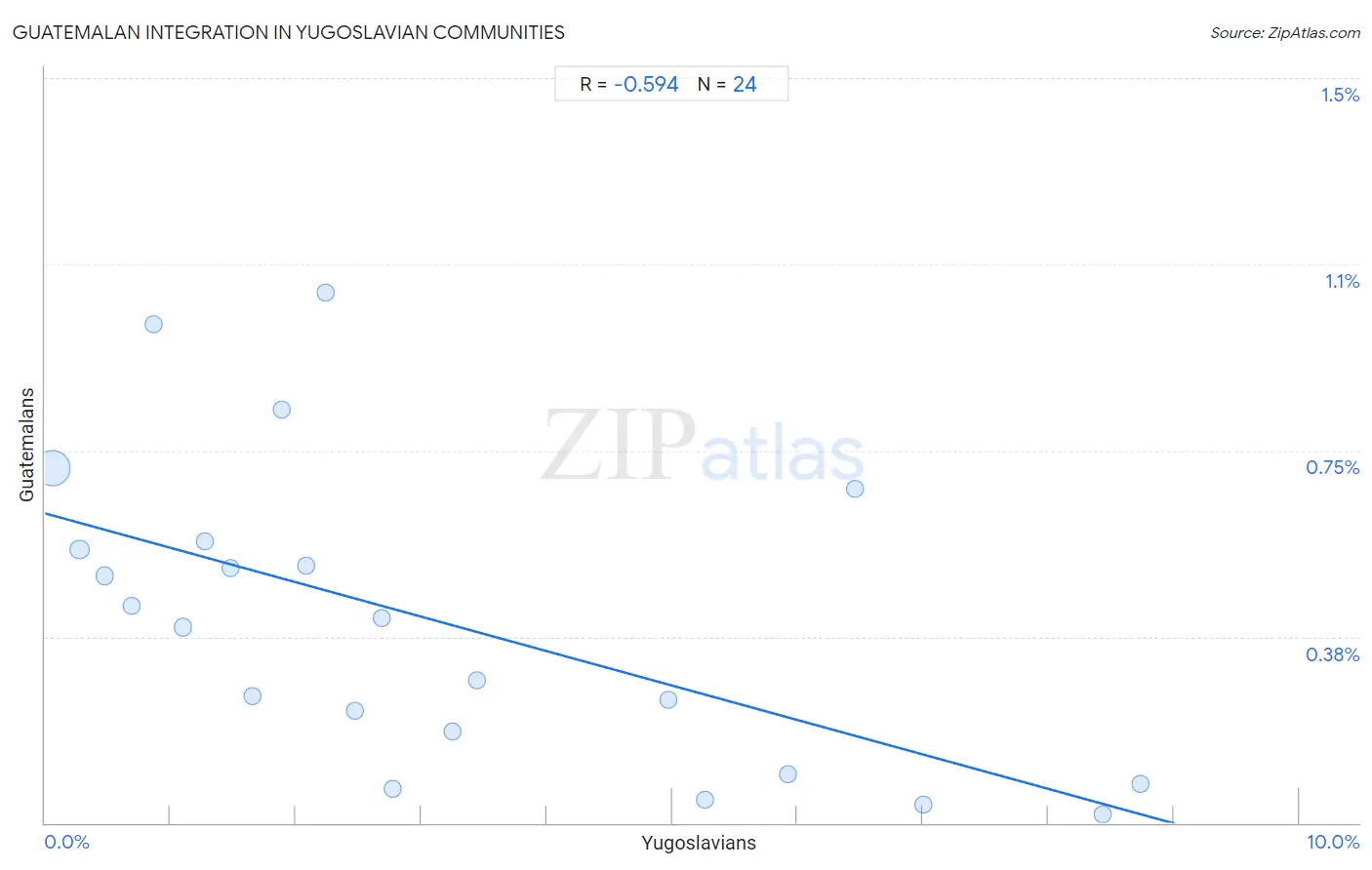
Yugoslavian vs Guatemalan Income
When considering income, the most significant differences between Yugoslavian and Guatemalan communities in the United States are seen in wage/income gap (26.7% compared to 22.6%, a difference of 18.0%), median male earnings ($53,967 compared to $46,736, a difference of 15.5%), and median family income ($100,119 compared to $88,295, a difference of 13.4%). Conversely, both communities are more comparable in terms of householder income under 25 years ($51,028 compared to $51,525, a difference of 0.97%), householder income over 65 years ($58,243 compared to $54,526, a difference of 6.8%), and median female earnings ($38,573 compared to $35,695, a difference of 8.1%).

| Income Metric | Yugoslavian | Guatemalan |
| Per Capita Income | Fair $42,792 | Tragic $37,766 |
| Median Family Income | Fair $100,119 | Tragic $88,295 |
| Median Household Income | Poor $82,186 | Tragic $75,961 |
| Median Earnings | Fair $45,846 | Tragic $41,205 |
| Median Male Earnings | Fair $53,967 | Tragic $46,736 |
| Median Female Earnings | Tragic $38,573 | Tragic $35,695 |
| Householder Age | Under 25 years | Tragic $51,028 | Poor $51,525 |
| Householder Age | 25 - 44 years | Poor $91,368 | Tragic $82,331 |
| Householder Age | 45 - 64 years | Fair $97,558 | Tragic $87,705 |
| Householder Age | Over 65 years | Tragic $58,243 | Tragic $54,526 |
| Wage/Income Gap | Tragic 26.7% | Exceptional 22.6% |
Yugoslavian vs Guatemalan Poverty
When considering poverty, the most significant differences between Yugoslavian and Guatemalan communities in the United States are seen in married-couple family poverty (4.6% compared to 7.0%, a difference of 51.6%), family poverty (8.5% compared to 11.7%, a difference of 37.4%), and seniors poverty over the age of 65 (10.0% compared to 13.5%, a difference of 35.3%). Conversely, both communities are more comparable in terms of single father poverty (16.3% compared to 16.6%, a difference of 2.3%), female poverty among 18-24 year olds (19.8% compared to 20.7%, a difference of 4.7%), and single male poverty (12.6% compared to 13.8%, a difference of 9.1%).
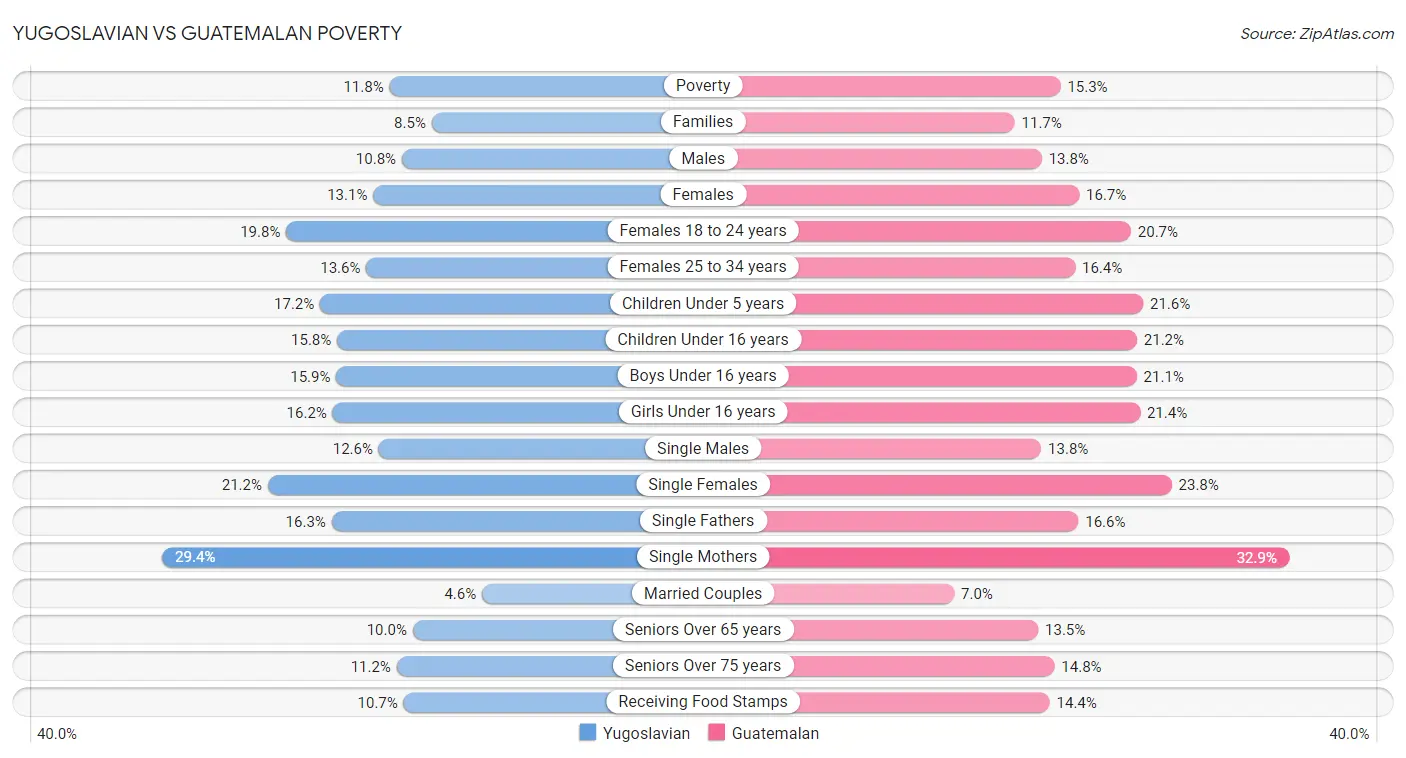
| Poverty Metric | Yugoslavian | Guatemalan |
| Poverty | Excellent 11.8% | Tragic 15.3% |
| Families | Excellent 8.5% | Tragic 11.7% |
| Males | Good 10.8% | Tragic 13.8% |
| Females | Good 13.1% | Tragic 16.7% |
| Females 18 to 24 years | Good 19.8% | Tragic 20.7% |
| Females 25 to 34 years | Average 13.6% | Tragic 16.4% |
| Children Under 5 years | Average 17.2% | Tragic 21.6% |
| Children Under 16 years | Good 15.8% | Tragic 21.2% |
| Boys Under 16 years | Good 15.9% | Tragic 21.1% |
| Girls Under 16 years | Good 16.2% | Tragic 21.4% |
| Single Males | Good 12.6% | Tragic 13.8% |
| Single Females | Fair 21.2% | Tragic 23.8% |
| Single Fathers | Average 16.3% | Poor 16.6% |
| Single Mothers | Fair 29.4% | Tragic 32.9% |
| Married Couples | Exceptional 4.6% | Tragic 7.0% |
| Seniors Over 65 years | Exceptional 10.0% | Tragic 13.5% |
| Seniors Over 75 years | Exceptional 11.2% | Tragic 14.8% |
| Receiving Food Stamps | Exceptional 10.7% | Tragic 14.4% |
Yugoslavian vs Guatemalan Unemployment
When considering unemployment, the most significant differences between Yugoslavian and Guatemalan communities in the United States are seen in female unemployment (4.8% compared to 6.0%, a difference of 25.4%), unemployment among women with children under 18 years (5.1% compared to 6.3%, a difference of 24.4%), and unemployment (4.8% compared to 5.8%, a difference of 19.2%). Conversely, both communities are more comparable in terms of unemployment among seniors over 75 years (9.1% compared to 8.8%, a difference of 3.4%), unemployment among ages 20 to 24 years (9.6% compared to 10.5%, a difference of 9.6%), and unemployment among women with children ages 6 to 17 years (8.5% compared to 9.3%, a difference of 9.8%).
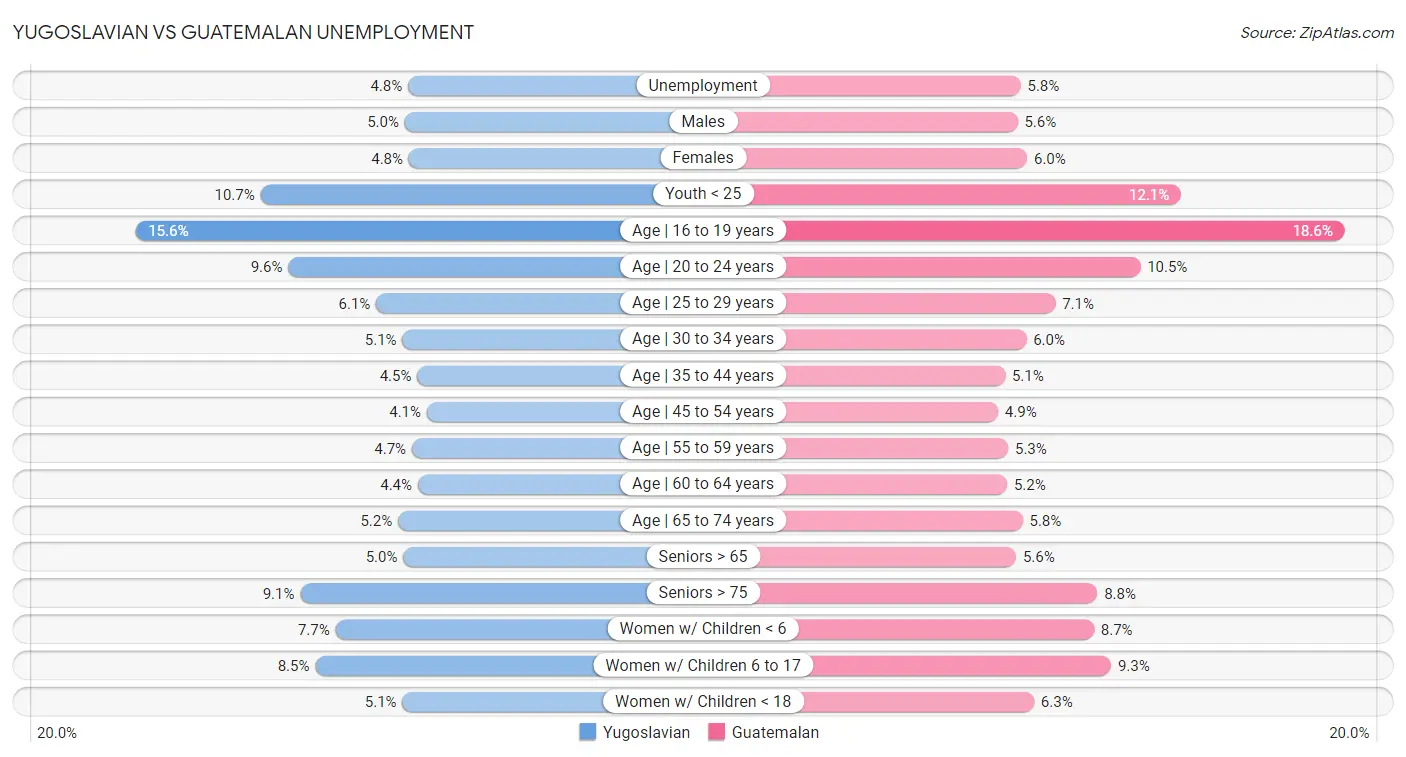
| Unemployment Metric | Yugoslavian | Guatemalan |
| Unemployment | Exceptional 4.8% | Tragic 5.8% |
| Males | Exceptional 5.0% | Tragic 5.6% |
| Females | Exceptional 4.8% | Tragic 6.0% |
| Youth < 25 | Exceptional 10.7% | Tragic 12.1% |
| Age | 16 to 19 years | Exceptional 15.6% | Tragic 18.6% |
| Age | 20 to 24 years | Exceptional 9.6% | Poor 10.5% |
| Age | 25 to 29 years | Exceptional 6.1% | Tragic 7.1% |
| Age | 30 to 34 years | Exceptional 5.1% | Tragic 6.0% |
| Age | 35 to 44 years | Exceptional 4.5% | Tragic 5.1% |
| Age | 45 to 54 years | Exceptional 4.1% | Tragic 4.9% |
| Age | 55 to 59 years | Exceptional 4.7% | Tragic 5.3% |
| Age | 60 to 64 years | Exceptional 4.4% | Tragic 5.2% |
| Age | 65 to 74 years | Exceptional 5.2% | Tragic 5.8% |
| Seniors > 65 | Exceptional 5.0% | Tragic 5.6% |
| Seniors > 75 | Tragic 9.1% | Fair 8.8% |
| Women w/ Children < 6 | Fair 7.7% | Tragic 8.7% |
| Women w/ Children 6 to 17 | Exceptional 8.5% | Tragic 9.3% |
| Women w/ Children < 18 | Exceptional 5.1% | Tragic 6.3% |
Yugoslavian vs Guatemalan Labor Participation
When considering labor participation, the most significant differences between Yugoslavian and Guatemalan communities in the United States are seen in in labor force | age 16-19 (41.8% compared to 35.5%, a difference of 17.7%), in labor force | age 20-24 (78.0% compared to 75.3%, a difference of 3.5%), and in labor force | age 35-44 (84.9% compared to 83.0%, a difference of 2.3%). Conversely, both communities are more comparable in terms of in labor force | age > 16 (65.4% compared to 65.6%, a difference of 0.29%), in labor force | age 30-34 (85.1% compared to 83.7%, a difference of 1.6%), and in labor force | age 20-64 (80.1% compared to 78.7%, a difference of 1.7%).

| Labor Participation Metric | Yugoslavian | Guatemalan |
| In Labor Force | Age > 16 | Excellent 65.4% | Exceptional 65.6% |
| In Labor Force | Age 20-64 | Exceptional 80.1% | Tragic 78.7% |
| In Labor Force | Age 16-19 | Exceptional 41.8% | Tragic 35.5% |
| In Labor Force | Age 20-24 | Exceptional 78.0% | Good 75.3% |
| In Labor Force | Age 25-29 | Exceptional 85.6% | Tragic 83.7% |
| In Labor Force | Age 30-34 | Exceptional 85.1% | Tragic 83.7% |
| In Labor Force | Age 35-44 | Exceptional 84.9% | Tragic 83.0% |
| In Labor Force | Age 45-54 | Good 83.0% | Tragic 81.2% |
Yugoslavian vs Guatemalan Family Structure
When considering family structure, the most significant differences between Yugoslavian and Guatemalan communities in the United States are seen in single father households (2.3% compared to 3.0%, a difference of 26.2%), single mother households (6.1% compared to 7.7%, a difference of 24.8%), and births to unmarried women (30.8% compared to 37.1%, a difference of 20.3%). Conversely, both communities are more comparable in terms of divorced or separated (12.3% compared to 12.2%, a difference of 1.4%), family households (63.1% compared to 65.2%, a difference of 3.4%), and married-couple households (46.2% compared to 43.3%, a difference of 6.9%).

| Family Structure Metric | Yugoslavian | Guatemalan |
| Family Households | Tragic 63.1% | Exceptional 65.2% |
| Family Households with Children | Tragic 27.0% | Exceptional 28.9% |
| Married-couple Households | Fair 46.2% | Tragic 43.3% |
| Average Family Size | Tragic 3.15 | Exceptional 3.40 |
| Single Father Households | Average 2.3% | Tragic 3.0% |
| Single Mother Households | Good 6.1% | Tragic 7.7% |
| Currently Married | Good 47.2% | Tragic 42.9% |
| Divorced or Separated | Tragic 12.3% | Fair 12.2% |
| Births to Unmarried Women | Good 30.8% | Tragic 37.1% |
Yugoslavian vs Guatemalan Vehicle Availability
When considering vehicle availability, the most significant differences between Yugoslavian and Guatemalan communities in the United States are seen in no vehicles in household (9.0% compared to 11.0%, a difference of 22.3%), 4 or more vehicles in household (6.3% compared to 7.0%, a difference of 10.9%), and 2 or more vehicles in household (56.6% compared to 54.1%, a difference of 4.5%). Conversely, both communities are more comparable in terms of 3 or more vehicles in household (19.7% compared to 20.1%, a difference of 1.9%), 1 or more vehicles in household (91.1% compared to 89.2%, a difference of 2.2%), and 2 or more vehicles in household (56.6% compared to 54.1%, a difference of 4.5%).

| Vehicle Availability Metric | Yugoslavian | Guatemalan |
| No Vehicles Available | Exceptional 9.0% | Poor 11.0% |
| 1+ Vehicles Available | Exceptional 91.1% | Poor 89.2% |
| 2+ Vehicles Available | Exceptional 56.6% | Tragic 54.1% |
| 3+ Vehicles Available | Good 19.7% | Excellent 20.1% |
| 4+ Vehicles Available | Average 6.3% | Exceptional 7.0% |
Yugoslavian vs Guatemalan Education Level
When considering education level, the most significant differences between Yugoslavian and Guatemalan communities in the United States are seen in no schooling completed (1.8% compared to 3.5%, a difference of 87.9%), doctorate degree (1.7% compared to 1.4%, a difference of 22.7%), and master's degree (14.4% compared to 11.7%, a difference of 22.4%). Conversely, both communities are more comparable in terms of nursery school (98.2% compared to 96.6%, a difference of 1.7%), kindergarten (98.2% compared to 96.5%, a difference of 1.7%), and 1st grade (98.2% compared to 96.5%, a difference of 1.7%).
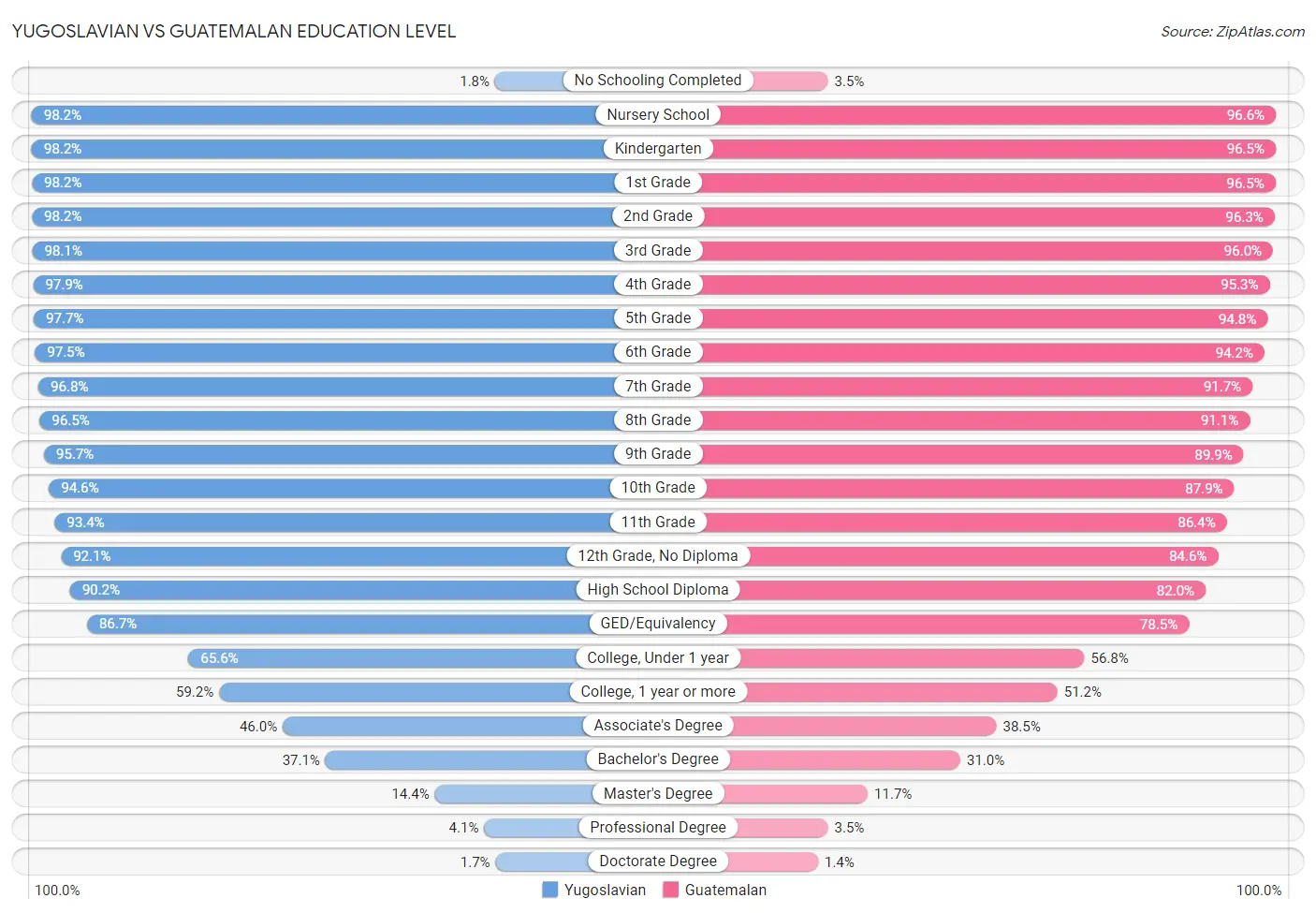
| Education Level Metric | Yugoslavian | Guatemalan |
| No Schooling Completed | Exceptional 1.8% | Tragic 3.5% |
| Nursery School | Exceptional 98.2% | Tragic 96.6% |
| Kindergarten | Exceptional 98.2% | Tragic 96.5% |
| 1st Grade | Exceptional 98.2% | Tragic 96.5% |
| 2nd Grade | Exceptional 98.2% | Tragic 96.3% |
| 3rd Grade | Exceptional 98.1% | Tragic 96.0% |
| 4th Grade | Exceptional 97.9% | Tragic 95.3% |
| 5th Grade | Exceptional 97.7% | Tragic 94.8% |
| 6th Grade | Exceptional 97.5% | Tragic 94.2% |
| 7th Grade | Exceptional 96.8% | Tragic 91.7% |
| 8th Grade | Exceptional 96.5% | Tragic 91.1% |
| 9th Grade | Exceptional 95.7% | Tragic 89.9% |
| 10th Grade | Exceptional 94.6% | Tragic 87.9% |
| 11th Grade | Exceptional 93.4% | Tragic 86.4% |
| 12th Grade, No Diploma | Exceptional 92.1% | Tragic 84.6% |
| High School Diploma | Exceptional 90.2% | Tragic 82.0% |
| GED/Equivalency | Excellent 86.7% | Tragic 78.5% |
| College, Under 1 year | Average 65.6% | Tragic 56.8% |
| College, 1 year or more | Average 59.2% | Tragic 51.2% |
| Associate's Degree | Average 46.0% | Tragic 38.5% |
| Bachelor's Degree | Fair 37.1% | Tragic 31.0% |
| Master's Degree | Fair 14.4% | Tragic 11.7% |
| Professional Degree | Poor 4.1% | Tragic 3.5% |
| Doctorate Degree | Poor 1.7% | Tragic 1.4% |
Yugoslavian vs Guatemalan Disability
When considering disability, the most significant differences between Yugoslavian and Guatemalan communities in the United States are seen in hearing disability (3.3% compared to 2.8%, a difference of 17.9%), disability age under 5 (1.4% compared to 1.2%, a difference of 16.2%), and disability age 18 to 34 (7.2% compared to 6.4%, a difference of 12.6%). Conversely, both communities are more comparable in terms of disability age 35 to 64 (11.7% compared to 11.7%, a difference of 0.51%), ambulatory disability (6.3% compared to 6.2%, a difference of 1.6%), and cognitive disability (17.2% compared to 17.8%, a difference of 3.4%).
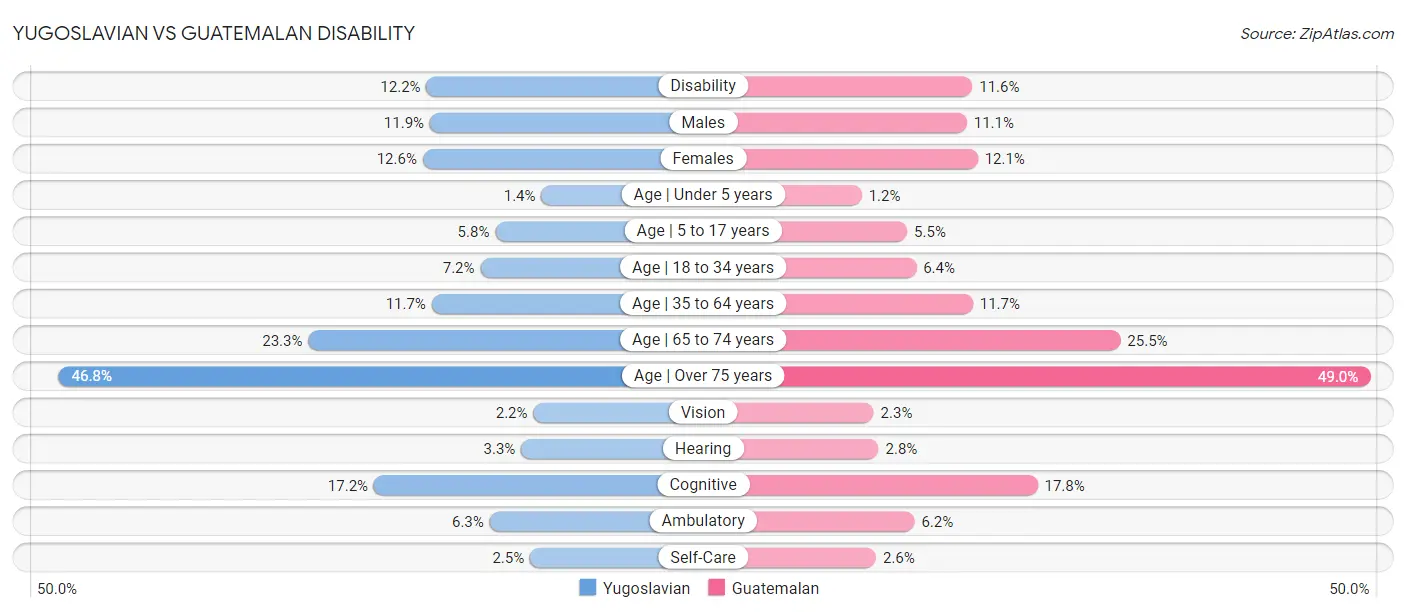
| Disability Metric | Yugoslavian | Guatemalan |
| Disability | Tragic 12.2% | Good 11.6% |
| Males | Tragic 11.9% | Good 11.1% |
| Females | Tragic 12.6% | Good 12.1% |
| Age | Under 5 years | Tragic 1.4% | Good 1.2% |
| Age | 5 to 17 years | Tragic 5.8% | Excellent 5.5% |
| Age | 18 to 34 years | Tragic 7.2% | Excellent 6.4% |
| Age | 35 to 64 years | Poor 11.7% | Poor 11.7% |
| Age | 65 to 74 years | Average 23.3% | Tragic 25.5% |
| Age | Over 75 years | Excellent 46.8% | Tragic 49.0% |
| Vision | Average 2.2% | Tragic 2.3% |
| Hearing | Tragic 3.3% | Exceptional 2.8% |
| Cognitive | Good 17.2% | Tragic 17.8% |
| Ambulatory | Poor 6.3% | Fair 6.2% |
| Self-Care | Fair 2.5% | Tragic 2.6% |